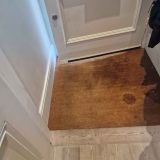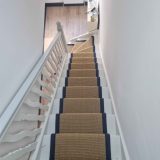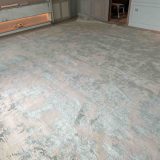Transforming Ealing Stairs with Client-Supplied Jute: Our Double Stick Fitting Expertise
Even on a less-than-sunny London day, some projects and locations brighten the mood! We recently found ourselves in lovely Ealing, right near the Common, undertaking a specific stair carpet fitting project for a client. The task? To expertly install a beautiful jute carpet which the client had sourced themselves.
While the client provided the star of the show – the natural jute carpeting – we handled the essential groundwork and technical fitting aspects. Jute is a fantastic choice for adding natural texture and warmth to a home (and we generally make jute stair runners ourselves), but being a natural fibre, it requires careful handling and a specific fitting technique for optimal results and longevity, especially on stairs.
The Plan:
Our proposed plan was clear and focused on achieving the best finish for the client’s chosen material:
- Preparation: Thankfully, no old flooring needed removing.https://fenstoncarter.co.uk/collections/ted-todd-wood-flooring-collections/products/ted-todd-project-engineered-wood-flooring-calico-narrow-herringbone
- Foundation: Supply and fit new, high-quality underlay and stair gripper.
- Fitting: Install the client’s jute carpet using the double stick method. This involves adhering the underlay to the steps and adhering the jute carpet to the underlay, ensuring maximum stability and preventing any shifting or wrinkling. The carpet is carefully stretched onto the grippers for a taut, perfect fit.
- Completion: Tidy up thoroughly, leaving the space clean and the new carpet looking its best.
[Image: stairs1.jpg – The staircase prepared and ready for transformation]
The Process: Mastering the Double Stick Method with Jute
With the stairs prepped, our first step was laying the foundation. We installed fresh gripper rods around the edges of the treads and risers, followed by a quality underlay. Choosing the right underlay is crucial, particularly with the double stick method, as it forms the base layer to which the carpet will be adhered.
[Image: stairs22.jpg – Fitting the new underlay and gripper, the essential base]
Then came the main event: fitting the client’s jute carpet. The double stick method requires precision. We applied a specialised adhesive to the underlay before carefully laying, stretching, and pressing the jute carpet firmly onto it. This ensures the carpet is fully secured across the entire surface of each step, not just held at the edges by the gripper. This method is ideal for natural fibres like jute as it minimises movement and enhances the carpet’s lifespan on high-traffic areas like stairs. Our team meticulously worked their way up the staircase, ensuring each step was perfectly covered and the jute’s natural weave was showcased beautifully.
[Image: stairs23.jpg – Carefully fitting the jute carpet using the double stick technique]
The Result
Despite the grey weather outside, the Ealing home was filled with the satisfaction of a job well done. The natural jute carpet brought warmth and texture to the staircase, completely transforming the space. The double stick method ensured a robust, high-quality finish that will stand the test of time. We finished with a thorough clean-up, leaving the client with nothing but their stunning new stairs to enjoy.
[Image: stairs21.jpg – The beautifully finished jute staircase in Ealing]
Working near Ealing Common was a pleasure, and we were thrilled to help the client bring their vision to life using the carpet they had personally selected. In fact we are back there next week when we are installing a beautiful Ted Todd Project Calico Narrow Herringbone floor. Should be fun.
Considering new stair carpet, especially natural fibres like jute, sisal, or seagrass? Contact us today to discuss the best fitting methods and how we can help transform your staircase!















